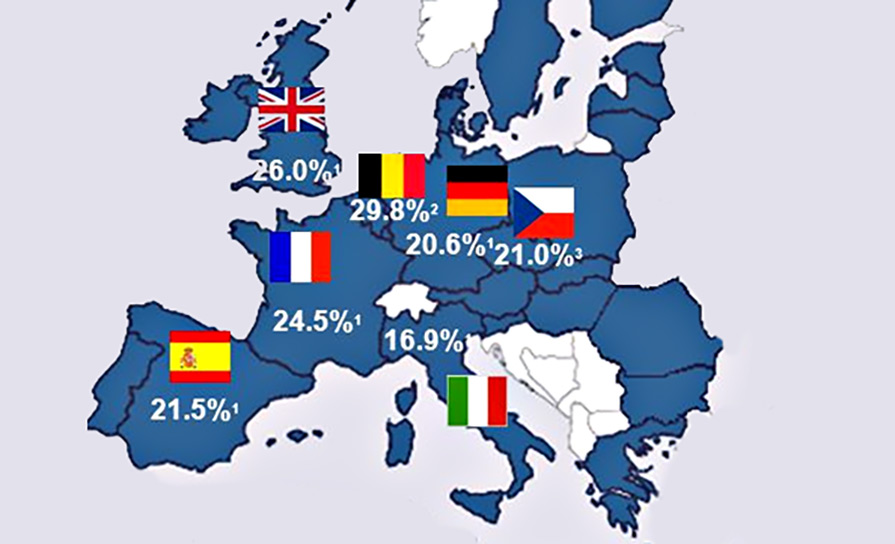Priscilla Lynch outlines the new 2018 updated European League Against Rheumatism (EULAR) evidence-based recommendations for the diagnosis of gout
In 2006, EULAR produced its first evidence-based recommendations for the diagnosis of gout. Since then, major advances have been made with regard to imaging, clinical diagnosis and understanding of the natural history of the disease. A number of studies have explored the diagnostic value of clinical algorithms and of imaging modalities such as ultrasound (US) or dual-energy computed tomography (DECT). The EULAR recommendations therefore needed to be revised and updated in the light of these advances in order to better assist physicians in diagnosing gout. This led to a revision of the 2006 recommendations by a specially-convened expert task force following an updated systematic literature review (SLR) and a Delphi process involving both experts and patients to achieve consensus.
The 2018 updated EULAR evidence-based recommendations for the diagnosis of gout were recently published as a paper in the Annals of the Rheumatic Diseases.
The paper provides eight key recommendations for the diagnosis of gout.
Key recommendations
The task force recommends a three-step approach for the diagnosis of gout. The first step relies on monosodium urate (MSU)crystal identification when synovial fluid (SF) analysis is feasible. If not possible, the second step relies on a clinical diagnosis based on suggestive and associated clinical features of gout and presence of hyperuricaemia. When a clinical diagnosis of gout is uncertain and crystal identification is not possible, the third step recommends imaging, particularly US, to search for imaging evidence of MSU crystal deposition.
In these updated EULAR recommendations, the identification of crystals using polarising microscopy remains the gold standard for the diagnosis of gout owing to its 100 per cent specificity. It is a single sufficient criterion for gout classification, according to the 2015 ACR/EULAR gout classification criteria. However, the task force acknowledges that this may have some limitations in a primary care setting, where most patients with gout are diagnosed and treated. Indeed, microscopic SF analysis requires both expertise and equipment that are not readily accessible for all physicians. Another barrier is the required expertise in joint puncture, and the challenge of aspirating SF, without patient discomfort, from small joints or from certain anatomical regions such as the mid-foot and wrist.
In patients suffering from acute arthritis and in whom SF analysis is not feasible, the task force recommends that the diagnosis of gout flare should be based both on certain suggestive clinical features and the serum uric acid (SUA) level. The task force considered that the level of evidence to support the use of any of the published algorithms was not sufficient for the diagnosis of gout in patients suffering from acute arthritis. Apart from the Janssens’ criteria, which were developed for use in clinical practice, the other recent algorithms were developed to classify patients and not to make a diagnosis at the individual level. In addition, for some of them, it has been shown that disease duration impacts on their performance, with lower specificity in established gout. The six clinical features selected in the second recommendation are derived from several algorithms, particularly the Janssens’ rule and the SUGAR study, because these had the best metrological performance among all the assessed variables when compared with crystal identification as reference.
In the second recommendation, the task force draws attention to the value of SUA levels for the clinical diagnosis of gout. Although there is no accepted definition of hyperuricaemia, the 6mg/dL (360µM) threshold has been proposed because the life-long risk of gout increases above this level. In the SUGAR study, the odds ratio (OR) of having gout versus not having gout was close to 6 for SUA levels between 6 and 8mg/dL, while this OR rose to 39 for SUA levels above 10mg/dL. However, as highlighted in the guidelines’ fourth recommendation, hyperuricaemia alone should not be used to diagnose gout, and should only be considered when there are suggestive clinical features for the diagnosis of gout. In general, crystallisation of MSU occurs when the SUA level exceeds its saturation point. This is not precisely known but it seems close to 6 mg/dL. However, nucleation and deposition of MSU crystals are very slow processes, depending on multiple genetic and environmental factors, including tissue nucleators and inhibitors. Among these, persistently high SUA levels are crucial. Thus, hyperuricaemia is a strong predictor of incident gout but not all patients with asymptomatic hyperuricaemia will develop gout. For instance, a recent study found that only half of patients with SUA levels above 10mg/dL will develop gout over 15 years, EULAR noted.
“The last decade has brought major advances in our understanding of the natural history of gout. In particular, the identification of a continuum between a preclinical state defined by asymptomatic MSU crystal deposition within joints and tendons, and occurrence of the first gout flare, has been facilitated by the use of novel imaging, such as US and DECT. This new knowledge has prompted the proposal of a novel staging for gout, which allows a diagnosis during the so-called intercritical period,” said EULAR.
Imaging
Among imaging modalities, US has been the most investigated, particularly in the SUGAR study and by Outcome Measures in Rheumatology (OMERACT). US features, notably the DC sign, have high specificity and good sensitivity, although the specificity is not so high in early gout. Since the advantages of US include low cost, lack of radiation exposure, ease of use and increasing availability in clinical practices, the EULAR task force prioritised US over other imaging modalities. In addition, US can identify associated inflammation using the Doppler mode. Since the sites for scanning varied across studies and because of a lack of standardisation, the task force recommends screening affected joints and at least both first MTP joints and the knees, which are common sites for MSU crystal deposition. US can also facilitate SF aspiration and MSU crystal identification from joints with US evidence for urate deposits, but without clinical effusion or inflammation.
DECT also allows non-invasive detection and characterisation of MSU crystal deposition in joints and soft tissues. This technique may be helpful, particularly in cases where US is not feasible or technically complicated (ie, spinal gout). However, it is not widely available, and in addition to being expensive and involving some radiation exposure, its use is often restricted to secondary and tertiary care centres. Its diagnostic performance, with MSU crystal identification as reference test, seems comparable to US, with a potential superiority for MSU crystal deposition detection in direct comparison with US. As observed with US, sensitivity for the diagnosis of gout is influenced by the duration of the disease, being lower in the early stage of the disease. Size and density of tophi also seem to influence the sensitivity for MSU crystal deposition detection. Lastly, reading and interpretation of images from DECT requires skill and expertise, and artefacts that could lead to false positivity have been reported, EULAR noted.
Both US and DECT could be useful to assess tophus resolution in response to urate-lowering therapy (ULT).
MRI and conventional CT both have the ability to identify MSU crystal deposition. However, their diagnostic performance has been less studied than US and DECT. MRI provides information with regard to the size of tophi, crystal-induced inflammation such as synovitis, and joint damage, including bone erosion. CT can also identify urate deposits but is more efficient in visualising bone damage. Therefore, the task force agreed that CT and MRI have limited utility for the diagnosis of gout in clinical practice, as compared with US or DECT.
Hyperuricaemia risk factors
The task force has emphasised in its two last recommendations the need to search for risk factors for hyperuricaemia once gout is diagnosed, noting that, importantly, some risk factors, notably obesity, medications (diuretics, low-dose aspirin, cyclosporine, tacrolimus) and diet are potentially modifiable. Lastly, the task force underlines the importance of screening for several comorbidities, in particular obesity, chronic kidney disease, cardiovascular diseases and components of the metabolic syndrome, which frequently coexist in patients with gout, but for which causality remains controversial.
Reference
Richette P, Doherty M, Pascual E, et al.
2018 updated European League Against Rheumatism evidence-based recommendations for the diagnosis of gout. Annals of the Rheumatic Diseases 2020;79:31-38.
Online publication 16 December 2019.
Updated EULAR gout diagnosis recommendations
Search for crystals in SF or tophus aspirates is recommended in every person with suspected gout, because demonstration of MSU crystals allows a definitive diagnosis of gout.
Gout should be considered in the diagnosis of any acute arthritis in an adult. When SF analysis is not feasible, a clinical diagnosis of gout is supported by the following suggestive features: Monoarticular involvement of a foot (especially the first MTP) or ankle joint; previous similar acute arthritis episodes; rapid onset of severe pain and swelling (at its worst in <24 hours ); erythema; male gender and associated cardiovascular diseases; and hyperuricaemia. These features are highly suggestive but not specific for gout.
It is strongly recommended that SF aspiration and examination for crystals is undertaken in any patient with undiagnosed inflammatory arthritis.
The diagnosis of gout should not be made on the presence of hyperuricaemia alone.
When a clinical diagnosis of gout is uncertain and crystal identification is not possible, patients should be investigated by imaging to search for MSU crystal deposition and features of any alternative diagnosis.
Plain radiographs are indicated to search for imaging evidence of MSU crystal deposition but have limited value for the diagnosis of gout flare. US scanning can be more helpful in establishing a diagnosis in patients with suspected gout flare or chronic gouty arthritis by detection of tophi not evident on clinical examination, or a double contour (DC) sign at cartilage surfaces, which is highly specific for urate deposits in joints.
Risk factors for chronic hyperuricaemia should be searched for in every person with gout, specifically: Chronic kidney disease (CKD) ; overweight; medications (including diuretics, low-dose aspirin, cyclosporine and tacrolimus); consumption of excess alcohol (particularly beer and spirits); non-diet sodas; meat; and shellfish.
Systematic assessment for the presence of associated comorbidities in people with gout is recommended, including obesity, renal impairment, hypertension, ischaemic heart disease, heart failure, diabetes and dyslipidaemia.













Leave a Reply
You must be logged in to post a comment.